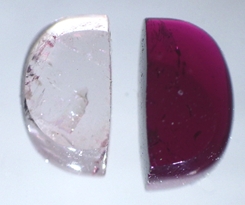
Heated elbaite on the left; Irradiated elbaite on the right:
The characteristic red color of many natural tourmalines is due to the presence of Mn(III) cations substituting for aluminum and lithium. These sites originate as Mn(II) and are oxidized by natural γ-irradiation over geologic time as they sit in the Earth’s crust. Presented here is a qualitative and quantitative analysis of the spin-allowed and spin-forbidden transitions which give rise to the color of these highly sought-after gemstones. A thorough ligand field analysis, supplemented by time-dependent density functional theory, was used to assign the optical transitions, which result from symmetry-allowed transitions in the polarized UV-visible absorption spectrum. Heat-induced reduction of the oxidized manganese sites provided a probe of the relationship between the spin-allowed and spin-forbidden bands. Notably, the intensity of the spin-forbidden transition was highly dependent on the neighboring ions in the structural Y-site. Kinetic simulations and modeling showed that increased intensity was observed only when two Mn(III) ions occupied adjacent substitutions in the Y-site. This enhancement could be enabled through an exchange-coupling mechanism, where the spin-forbidden transition gained intensity by coupling to a more intense transition with similar energy.
